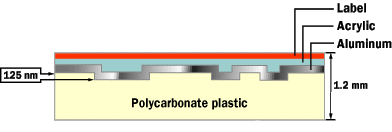Reading & Writing CDs
In the last section, we saw that conventional CDs store digital data as a pattern of bumps and flat areas, arranged in a long spiral track. The CD fabrication machine uses a high-powered laser to etch the bump pattern into photoresist material coated onto a glass plate. Through an elaborate imprinting process , this pattern is pressed onto acrylic discs. The discs are then coated with aluminum (or another metal) to create the readable reflective surface. Finally, the disc is coated with a transparent plastic layer that protects the reflective metal from nicks, scratches and debris.
 The different layers of a conventional CD |
As you can see, this is a fairly complex, delicate operation, involving many steps and several different materials. Like most complex manufacturing processes (from newspaper printing to television assembly), conventional CD manufacturing isn't practical for home use. It's only feasible for manufacturers who produce hundreds, thousands or millions of CD copies.
Consequently, conventional CDs have remained a " read only " storage medium for the average consumer, like LPs or conventional DVDs . To audiophiles accustomed to recordable cassettes , as well as computer users who were fed up with the limited memory capacity of floppy disks , this limitation seemed like a major drawback of CD technology. In the early '90s, more and more consumers and professionals were looking for a way to make their own CD-quality digital recordings.
In response to this demand, electronics manufacturers introduced an alternative sort of CD that could be encoded in a few easy steps. CD-recordable discs , or CD-Rs , don't have any bumps or flat areas at all. Instead, they have a smooth reflective metal layer, which rests on top of a layer of photosensitive dye .
When the disc is blank, the dye is translucent : Light can shine through and reflect off the metal surface. But when you heat the dye layer with concentrated light of a particular frequency and intensity, the dye turns opaque : It darkens to the point that light can't pass through.
A CD-R doesn't have the same bumps and lands as a conventional CD. Instead, the disc has a dye layer underneath a smooth, reflective surface. On a blank CD-R disc, the dye layer is completely translucent, so all light reflects. The write laser darkens the spots where the bumps would be in a conventional CD, forming non-reflecting areas.
By selectively darkening particular points along the CD track, and leaving other areas of dye translucent, you can create a digital pattern that a standard CD player can read. The light from the player's laser beam will only bounce back to the sensor when the dye is left translucent, in the same way that it will only bounce back from the flat areas of a conventional CD. So, even though the CD-R disc doesn't have any bumps pressed into it at all, it behaves just like a standard disc.
A CD burner's job, of course, is to "burn" the digital pattern onto a blank CD. In the next section, we'll look inside a burner to see how it accomplishes this task.
Back to How It Works
› Introduction to How CD Burners Work
› CD Basics
› Reading & Writing CDs
› Burning CDs
› Erasing CDs
› CD Formats
› Creating Your Own CDs